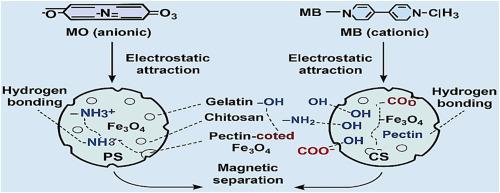Magnetically retrievable 3D biopolymer sponges for enhanced removal and recycling of organic dyes
IF 10
1区 环境科学与生态学
Q1 ENGINEERING, ENVIRONMENTAL
引用次数: 0
Abstract
Synthetic dyes possess high toxicity, chemical stability, and resistance to biodegradation, posing severe environmental hazards. Therefore, their efficient removal from wastewater is essential. In this study, biodegradable and magnetically retrievable hybrid biopolymer sponges were fabricated from a gelatin–chitosan (Gel–Chi) matrix via freeze-drying and reinforced with Fe3O4 magnetic nanoparticles (MNPs) and pectin-coated Fe3O4 magnetic nanocomposites (MNCs). The resulting porous Gel–Chi–MNP (PS) and Gel–Chi–MNC (CS) sponges exhibited hierarchical porosity, tunable surface charge, and robust mechanical stability. Adsorption studies using methylene blue (MB, cationic) and methyl orange (MO, anionic) revealed maximum adsorption capacities of 312.4 mg g−1 for MB and 276.8 mg g−1 for MO under optimized conditions. Adsorption isotherms followed both Langmuir and Freundlich models, confirming the coexistence of monolayer and heterogeneous multilayer adsorption, while kinetic analysis indicated a hybrid mechanism involving physisorption and chemisorption. Notably, CS sponges displayed superior swelling capacity, higher reusability, and improved structural integrity compared with PS sponges, owing to the pectin coating that enhanced hydrophilicity and electrostatic interactions. The sponges retained >85 % of their dye removal efficiency after five successive adsorption–desorption cycles, demonstrating excellent regeneration potential. Furthermore, cost analysis and preliminary tests with metal ions validated their economic viability and versatility for practical wastewater treatment. Thereby, the Gel–Chi–MNC sponges represent sustainable, scalable, and environmentally friendly adsorbents for efficient dye removal and recycling.

磁性可回收的3D生物聚合物海绵,用于增强有机染料的去除和回收
合成染料具有毒性高、化学稳定性好、耐生物降解等特点,对环境危害严重。因此,从废水中有效去除它们是至关重要的。在本研究中,以明胶-壳聚糖(Gel-Chi)为基体,通过冷冻干燥制备了可生物降解和磁性可回收的杂化生物聚合物海绵,并用Fe3O4磁性纳米颗粒(MNPs)和果胶包覆的Fe3O4磁性纳米复合材料(MNCs)进行增强。所得多孔凝胶- chi - mnp (PS)和凝胶- chi - mnc (CS)海绵具有分层孔隙度、可调表面电荷和强大的机械稳定性。亚甲基蓝(MB,阳离子)和甲基橙(MO,阴离子)的吸附研究表明,在优化条件下,MB和MO的最大吸附量分别为312.4 mg g−1和276.8 mg g−1。吸附等温线符合Langmuir和Freundlich模型,证实了单层和非均相多层吸附的共存,而动力学分析表明了物理吸附和化学吸附的混合机制。值得注意的是,由于果胶涂层增强了亲水性和静电相互作用,与PS海绵相比,CS海绵具有更好的膨胀能力、更高的可重复使用性和更好的结构完整性。在连续五次吸附-解吸循环后,海绵的染料去除率保持在85%,显示出良好的再生潜力。此外,成本分析和金属离子的初步测试验证了它们在实际废水处理中的经济可行性和多功能性。因此,Gel-Chi-MNC海绵代表了可持续的、可扩展的和环保的吸附剂,用于有效的染料去除和回收。
本文章由计算机程序翻译,如有差异,请以英文原文为准。
求助全文
约1分钟内获得全文
求助全文
来源期刊

Journal of Cleaner Production
环境科学-工程:环境
CiteScore
20.40
自引率
9.00%
发文量
4720
审稿时长
111 days
期刊介绍:
The Journal of Cleaner Production is an international, transdisciplinary journal that addresses and discusses theoretical and practical Cleaner Production, Environmental, and Sustainability issues. It aims to help societies become more sustainable by focusing on the concept of 'Cleaner Production', which aims at preventing waste production and increasing efficiencies in energy, water, resources, and human capital use. The journal serves as a platform for corporations, governments, education institutions, regions, and societies to engage in discussions and research related to Cleaner Production, environmental, and sustainability practices.
 求助内容:
求助内容: 应助结果提醒方式:
应助结果提醒方式:


